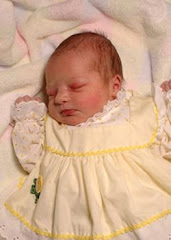IEP Meeting!
Emily's goals are to consistently use verbal, signing or PEC's (picture boards) communication 75% of the time during circle time, snack time & table time. She will be receiving at least 90 minutes of ST a month. Which will be in the classroom so that the Speech Therapist is able to work with her on the things she is doing in class. It essentially breaks down to approximately 23 minutes a week. So once we combine that with in home speech therapy, she will be getting at least 1 1/2 hours a week. Which at this age I am okay with.
Emily gets a little overwhelmed when our therapy sessions are long. We have decided to break them into 30 minute sessions (at home). We are also partnering with our home Speech Therapist to create a "at home therapy" program that Matt & I will be doing with her 2-3x a day. Most of it will consist of Oral-Motor Therapy. There is information on Oral-Motor Speech Therapy below. We are also continuing to learn & teach signs everyday (we love signing time)! We are going to begin to use PEC's at home just until we either learn the sign for it or learn how to verbally say it (mostly so she knows how to use it when she goes to school). Unfortunately we will be losing at home speech therapy for about a month & a half. This is due to Matt's new insurance not beginning until the end of April. We do currently have insurance but it isn't very good, especially for this sort of stuff. Once we have our new insurance we have to pay for the deductable first! Yikes!
What is Oral-Motor Speech Therapy?
Therapy designed for patients with muscle-based speech disorders related to poor muscle strength and difficulty with motor planning/coordination for speech movements. This approach uses therapy tools to systematically improve oral muscle movements.
Why use Oral-Motor Speech Therapy?
Normal muscle movement must exist for standard speech clarity to develop. Patients with muscle-based disorders do not have the muscle strength or endurance to support the development of intelligible speech (Rosenfeld-Johnson).
Many individuals who may benefit from an Oral-Motor Program are able to speak in short phrases or even in complete sentences, but they are very difficult to understand. If the muscle weakness is not addressed, these patients will continue to exhibit speech problems, specifically in connected speech (Rosenfeld-Johnson).
How Does Oral-Motor Speech Therapy Work?
Oral-Motor Speech Therapy uses a muscle-strengthening program in conjunction with traditional speech remediation techniques to:
. increase oral awareness
. develop correct placement for sound production
. increase strength within the oral musculature
. improve motor planning for speech movements
. improve speech clarity
Who Can Benefit?
Patients who experience excessive drooling, tongue thrust (tongue sticks out when talking), open mouth posture, weak breath support, speech that is difficult to understand, weak oral muscles (lips, tongue, jaw), lisping, poor oral awareness, or feeding problems can potentially benefit from an Oral Motor Program.











No comments:
Post a Comment